The Gibbon Experience, Laos

Black-crested Gibbon, Nomascus concolor
For a few years now I had wanted to visit the Gibbon Experience, which combines ziplining, spectacular treehouse accommodation and a chance to see critically endangered Black-crested Gibbons. And a trip through Asia with my kids in July 2017 gave me an opportunity to have fun with two teenagers and look for a new mammal.
On paper, the project sounds wonderful. All the more so when you consider how important the income raised should be to protecting the forest and the gibbons, of which only a couple of hundred remain in Laos from a global population of 1,000-2,0000. In practice it was not quite what I was expecting: the Gibbon Experience felt more like a production line than a eco-project, and I had some safety concerns that might be worth bearing in mind if you plan to visit.
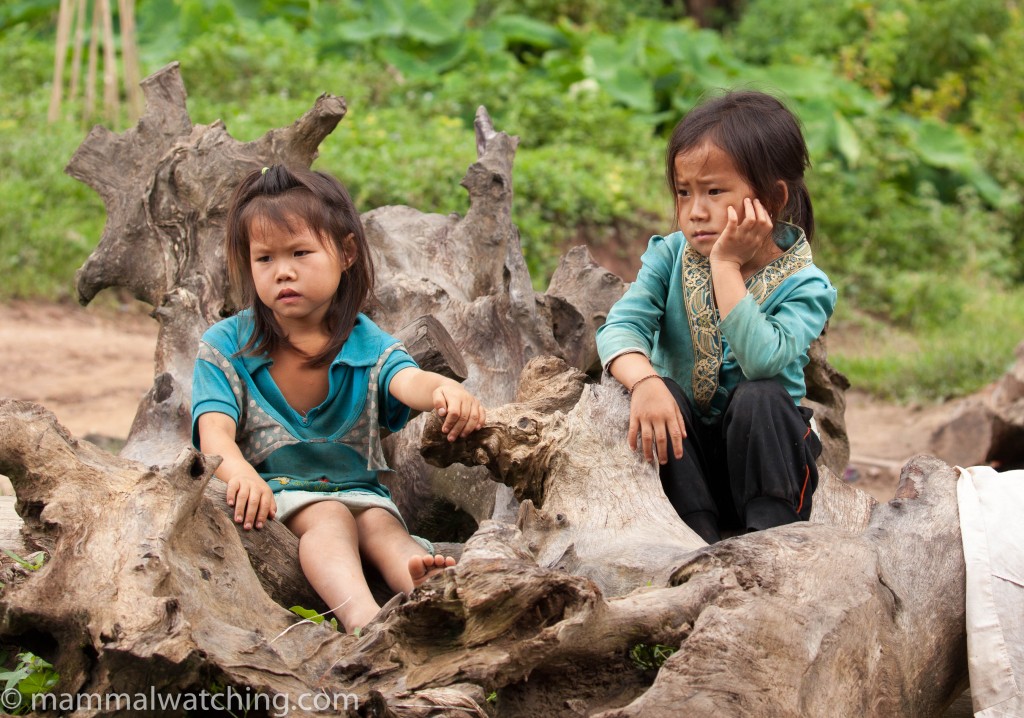
The Gibbon Experience offer 2 night/3 days trips into the Nam Kan National Park daily. I took my kids in the middle of July which is the thick of the rainy season. Conditions were pretty tough. Trips leave from the Laos border town of Houay Xai (which is spelt in various ways depending on what map you look at). The border is easy to reach from Chiang Mai in Thailand, via bus or taxi to the border station at Chiang Khong on the Thai side of the bridge across the Mekong. From there it is a quick shuttle bus to the Laos border control and then a tuktuk to town. Bear in mind the border shuts at 6 p.m. each day.
Trips leave at 8.30 a.m. each morning from the Gibbon Experience offices.
Getting to the forest is part of the fun. We took the “classic” tour itinerary (supposedly the best for seeing the gibbons), and travelled in pick-up trucks for an hour along a tarred road to a small village. From there, after crossing a river, we took more rugged vehicles up the mountain. In the dry season this drive should take about an hour. It took us three: three hours of spinning, sliding – and sometimes walking – up steep and stupendously muddy roads. Check out this video.
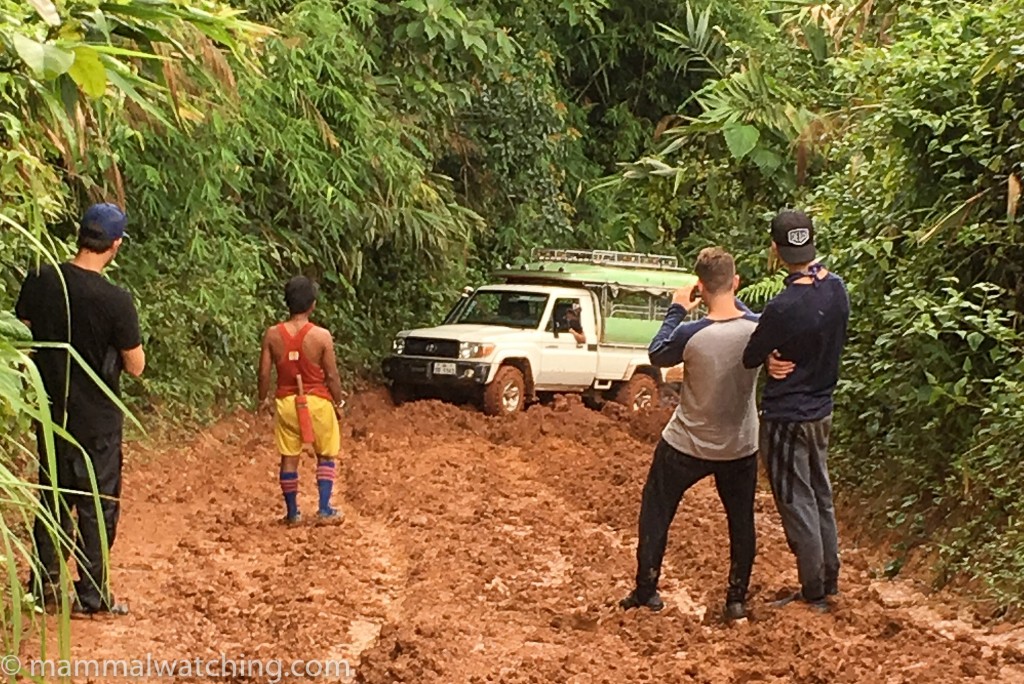
Wet season roads
I would not have believed anything other than a tractor could have gotten through the mud, which was occasionally over the vehicle’s tow bar. But our driver managed to get the vehicle up with the help of a lot of burnt clutch and a team of men with hoes, who frequently leaped out of the vehicles to cut a rut down to the bedrock through the 2ft mud. Vehicles occasionally cannot get up the road in the wet season: and this would means an extra three hours very unpleasant walk.
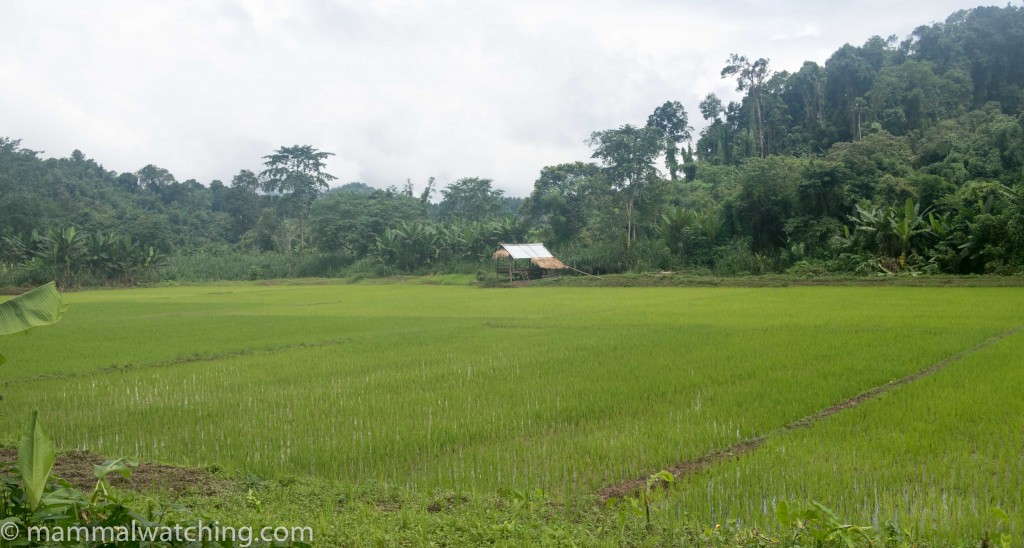
We made it to a village at the end of the road. From there it is a steep, slippery and sometimes ankle deep in mud, walk up a mountain to reach the start of the ziplining circuit.
These trips, though quite expensive at 250 euros per person, seem primarily aimed at backpackers and observing wildlife comes second to ziplining adventure. Participants are expected to travel through the forest – and stay in treehouses – in a group. The twelve people taking our tour were put into two groups of six and our groups were expected to swap treehouses each night.
More importantly no special effort was made to see the gibbons: it is really down to luck as to whether you bump into them on a trail or they swing past your tree house. This only became clear to me when we were at the Gibbon Experience offices. When I asked if I could pay extra to have a private guide so I could focus on wildlife, rather than ziplining, I was simply told “We don’t do that”.
Safety was also something of an afterthought (if any thought at all). The night we arrived in Laos I googled the Gibbon Experience to try to reassure my daughter about how much fun it would be. Unfortunately the first thing that came up was the news of a fatality from a couple of months earlier. This didn’t do much to set her mind at rest.
It didn’t do much for my peace of mind either. Nor did the waiver we had to sign at the offices: the project isn’t liable for any accident, no matter whose fault it might be.
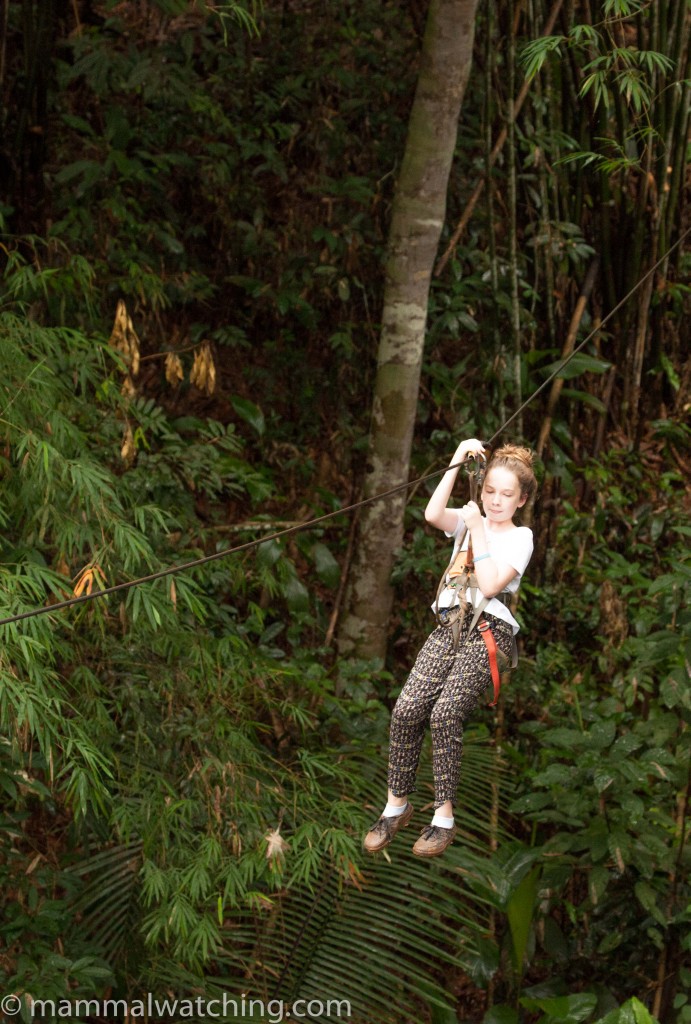
Katy: Queen of the Jungle
I had ziplined before in South Africa so wasn’t all that concerned. In retrospect I should have been. And for several reasons.
First, when we started ziplining our group of six people were given only one guide. Normally, he explained, we should have two, but it was just him today. None of the others in our group had ziplined before. Our guide gave a three minute introduction (to back up the three minute safety video we had been show in town), clipped onto the cables and disappeared to the other end of the line, leaving us to clip on and follow without supervision. Somewhat disconcerting.
Second, on several of the platforms you cannot see all the way to the other end of the line. Having only one guide meant group members had to decide for themselves when the line was clear and it was safe to start ziplining.
Third, I had not realised that we had to zipline carrying all our gear on our backs. We were asked to leave heavy bags at the offices but I had mistakenly assumed that porters would get our camera gear into the treehouses. Carrying 15 kg of photo gear up the mountain was one thing. Ziplining with it on my back quite another.
Fourth, several of the ziplines had only a small difference in elevation from one end to the other. And so, from a lack of momentum, most of us would stop short of the exit platform and have to pull ourselves the final ten or 20 metres. This wasn’t too tiring without a pack. But it required a lot of effort with a pack as heavy as mine.
These four factors all, unfortunately, coincided for me on the second line. Our first- 100m or so – zipline was truly spectacular as we got our first taste of flying over the trees and through the mist. Excited, and nervous about my kids on their own, I jumped off the platform onto the second, much longer line. But my heavy backpack was unstable (not helped because I forgot to fasten the waist strap) and I twisted though 180 degrees as I was sailing down the line so that I was facing backwards. This need not be a problem, but it undoubtedly slowed me down. And that meant a long pull to the exit platform after I stopped zipping.
But I had forgotten to put on my gloves. The cable was biting into my hands and, exhausted by the long pull and heavy pack, the cable slipped out of my grasp. Next thing I knew I was dangling upside down from my waist harness and flying back along the zipline (some other ziplines have a safety harness to stop you falling upside down like this).
I came to a halt in the middle of the line. And there I dangled, at least 30 metres above the forest floor. My pack so heavy I wasn’t able to pull myself up. There wasn’t much I could do so I waited for help and hoped my harness would hold and my pack wouldn’t slip off.
Help eventually arrived when my guide came back down the line to rescue me. He tried to pull me to safety. But this required a herculean effort from him and half way back along the line I think it is fair to say he started to panic. He wanted me to drop my pack – all $15,000 worth of camera gear – into the abyss below. I managed to hang onto it until I was closer to the platform and only 15 metres above the ground, at which point I figured the branches of the trees below me would break the fall (they did: and cameras, lenses, thermal scope and phone survived intact).
Long story short, both my guide and I were clearly very concerned about what might happen for me to have dropped my pack. Once I jettisoned my backpack, I was able to pull myself up and help pull along the line. But, all the same, we barely managed to get ourselves back to the platform. All this would have been less of a problem I think had we had a second guide, but without back up it was really quite scary. But it was almost much worse. My son was behind me in the zipline queue and when, five minutes after I had left, he had not had a clear signal to go, he figured it was safe to leave (he couldn’t see the end of the line). He had clipped on to the cable and even taken a step off the platform when one of the kitchen staff happened to arrive and told him to wait (probably because she had seen me dangling). Had she not turned up at that very second he would surely have crashed into me on the cable and I really don’t like to think what would have happened.
When I got back onto terra firma I felt like I had lost one of my nine lives. I had definitely lost a sizeable chunk of flesh from my ankle after I had tried to pull myself by throwing my legs around the cable. I’ve had a few near misses over the years but this was one of the scariest. It was my fault: if I had remembered my gloves and fastened the waist strap on my pack it wouldn’t have happened. But it was easy to get distracted when you are trying to look after other people too.
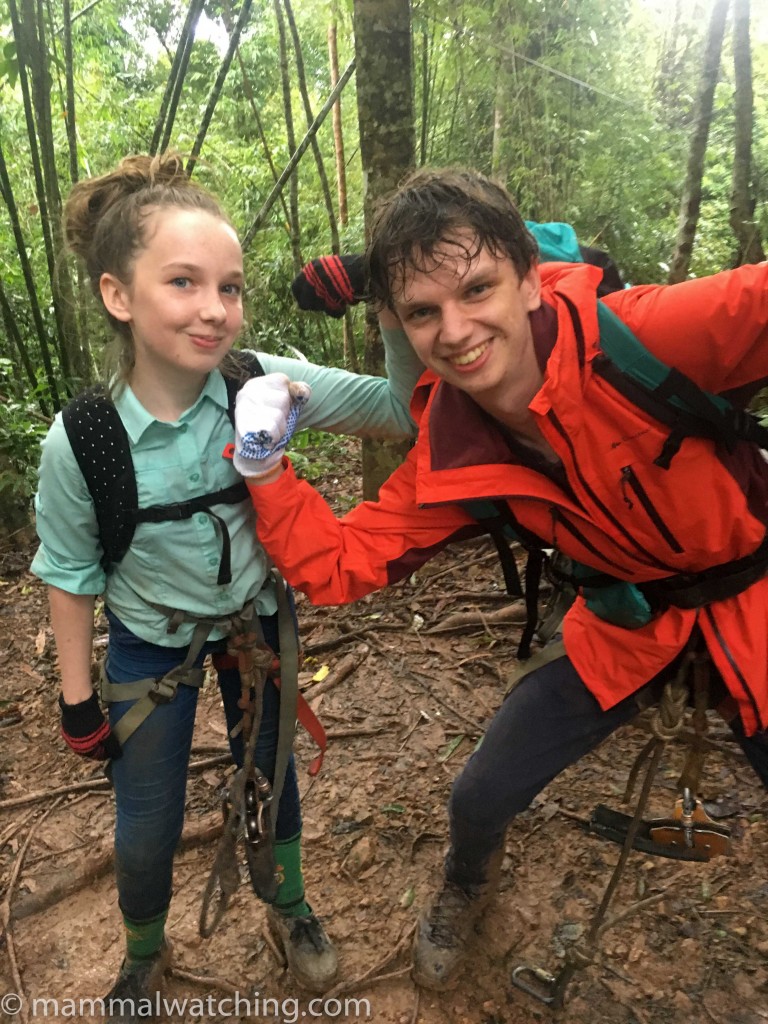
Patrick and Katy: masters of the Universe.
Having said all that, the ziplining (without a pack) was exhilarating and the treehouse themselves are a spectacular feat of engineering with a glorious view. Tasty food was delivered to us three times a day via zipline. So, once I had recovered from the trip in, we enjoyed our stay. We were lucky too with the rest of the visitors in our group: all pleasant, quiet and interested in wildlife. Surely not always the case.
Wildlife Watching
Black-crested Gibbons are the main mammalian reason to visit the forest. Phayre’s Langurs are also present though I was unable to get any information on how often they are encountered. Diurnal primates aside, there ought to be a chance for some good mammals in the forest at night, including Spotted Linsang (photographs of an animal are on the project’s website) and Pygmy Loris. But travel in the forest at night is difficult: access to each treehouse is only via zipline and the guides return to the village each afternoon. Heading out after dark would mean solo ziplining at night. I am not sure that is such a great idea. And, in the wet season, the trails are so slippery it would be extremely hard to spotlight in any case. We also heard gunshots at night: I would not have wanted to run into poachers on the trails.
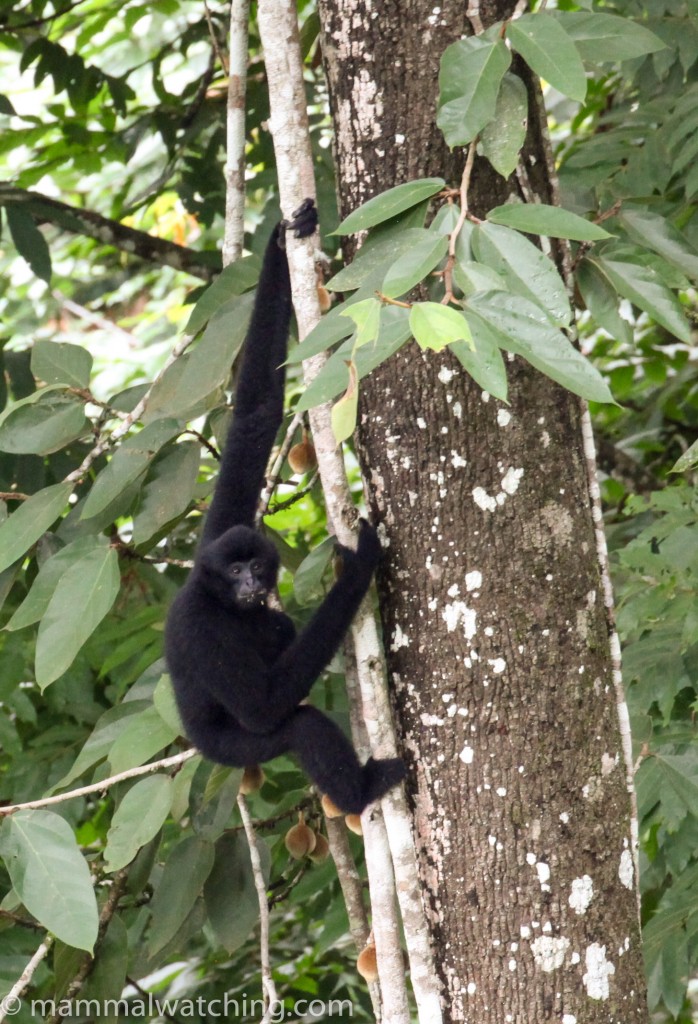
Black-crested Gibbon, Nomascus concolor
Though we were expected to swap treehouses during our two nights, the kids and I spent both nights in the same treehouse, because:
a) my daughter had already had enough of trekking through the mud. The project’s website claims the classic tour is the “easiest trek” with “one hour of reasonably hilly access” .. hmmm…. they also claimed it was suitable for anyone from 12 – 80. The thought of another two hours march to Treehouse No. 5 wasn’t doing it for her;
b) I figured we might have a better chance of seeing gibbons by staying put and scanning from our vantage point; and
c) I was freaked out after my brush with the death the day before and was in no hurry to zipline again. My guide said we could walk alone in the daytime if we wanted. But I figured the treehouse – with a commanding view of a decent swathe of the canopy – was the best place to look for the gibbons
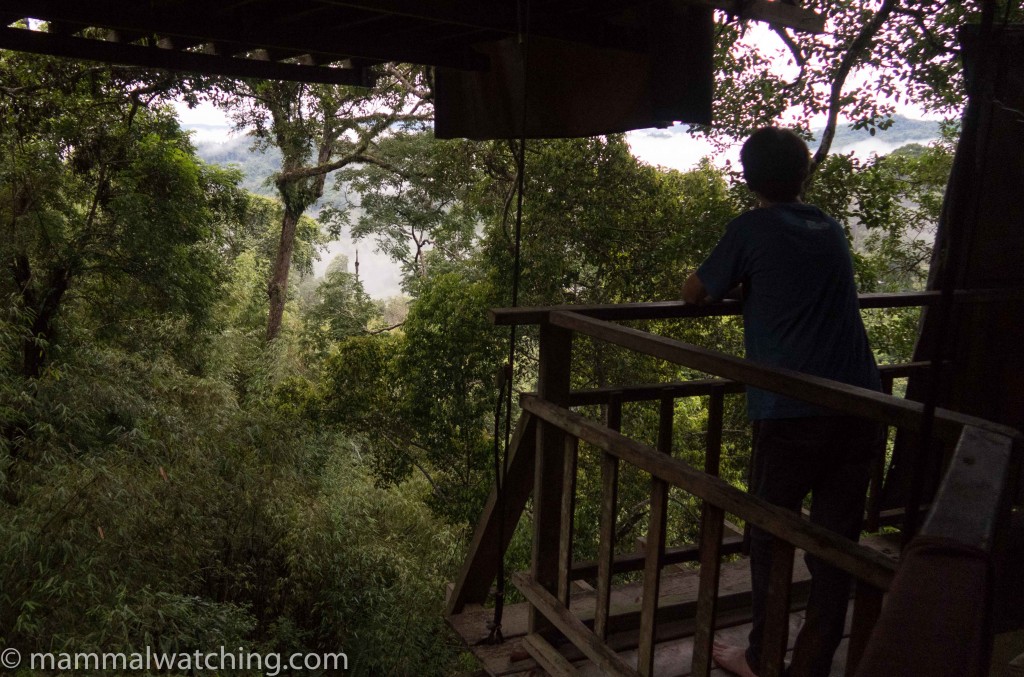
The view from Treehouse No. 1
The Mammals
The project’s website claims that 70% of people see gibbons. We heard them on our first morning and saw a group later that afternoon. We had excellent and prolonged views of half a dozen animals. However, had I left our treehouse to swap accomodation, as I was supposed to, I would have missed them. Indeed the rest of our original group, who did leave our treehouse, didn’t see any gibbons during their visit.
I spent a good deal of time scanning for wildlife with my heat scope. Early in the morning I saw several reddish-brown squirrels with distinctive black-tipped tails: the local race of Pallas’s Squirrel I think.
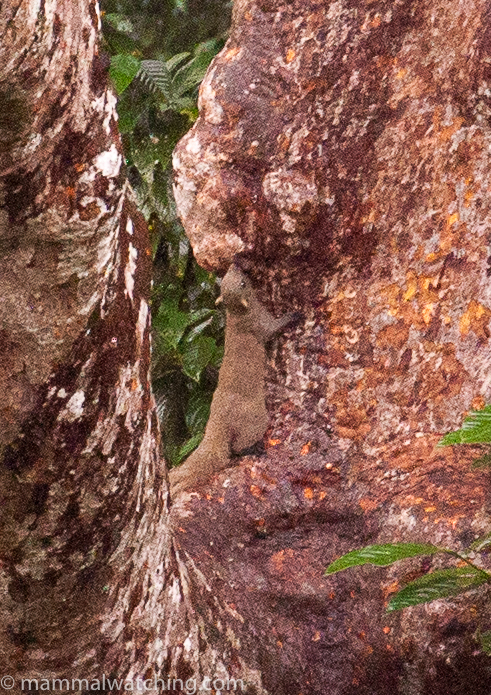
Pallas’s Squirrel, Callosciurus erythraeus
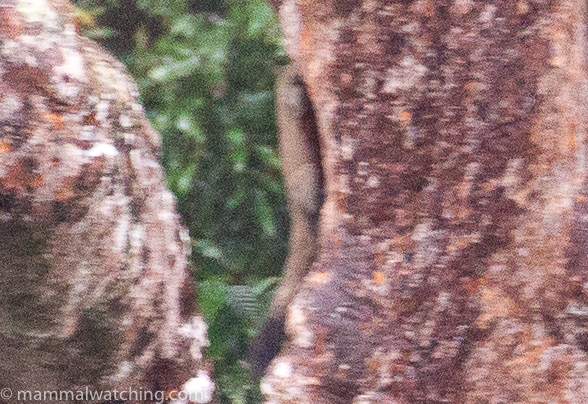
Pallas’s Squirrel, Callosciurus erythraeus: terrible picture but note the very pronounced black tail tip.
After dark I saw a few distant and unidentifiable rats in the trees (though none in our treehouse as our guide had predicted). I also saw a Slow Loris in a nearby tree, but not well enough to be sure whether it was a Bengal or Pygmy Slow Loris as both ought to be in range.
If I had had a chance to walk at night then I might have seen a bit more I suppose, particularly in the dry season. Though I might not have made it back to the treehouse.
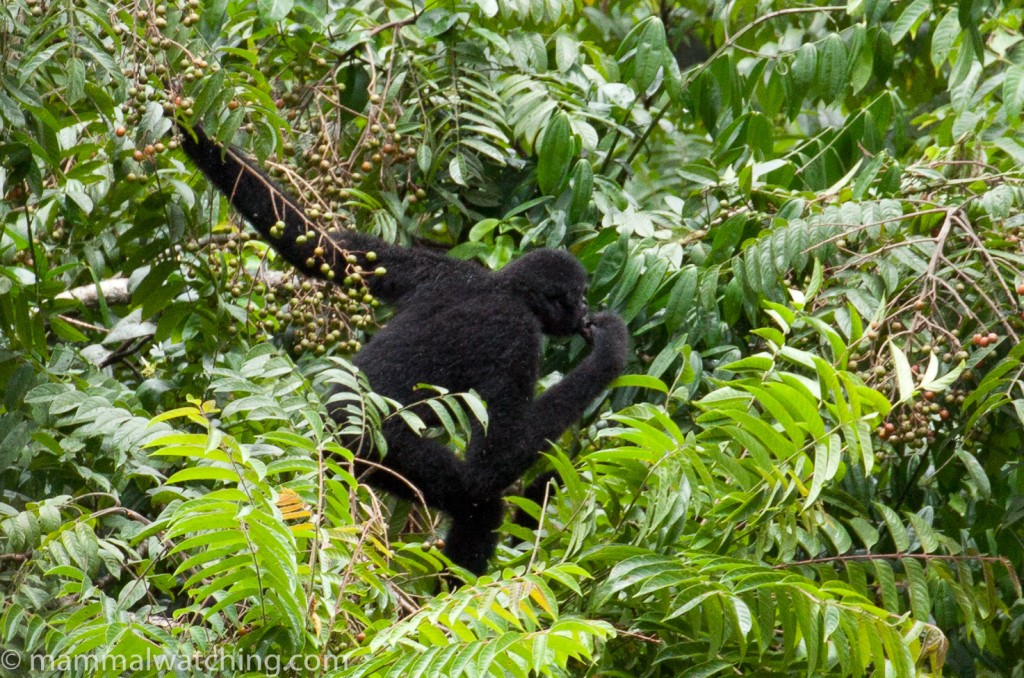
Black-crested Gibbon, Nomascus concolor
The forest itself is beautiful. And though poaching continues, the thousands of dollars earned each day by the Gibbon Experience must surely be helping to reduce hunting.
I didn’t have time to look elsewhere in Laos but if it had been less wet the day we arrived I would have take a stroll through the village to look for Irrawaddy Squirrels which ought to be fairly common in secondary forest in the area.
In short, I have mixed feelings. Glad I went but it would take a lot of persuade me to return. If you do go then learn from my mistakes: pack a light bag, remember your gloves and insist on having a second guide.
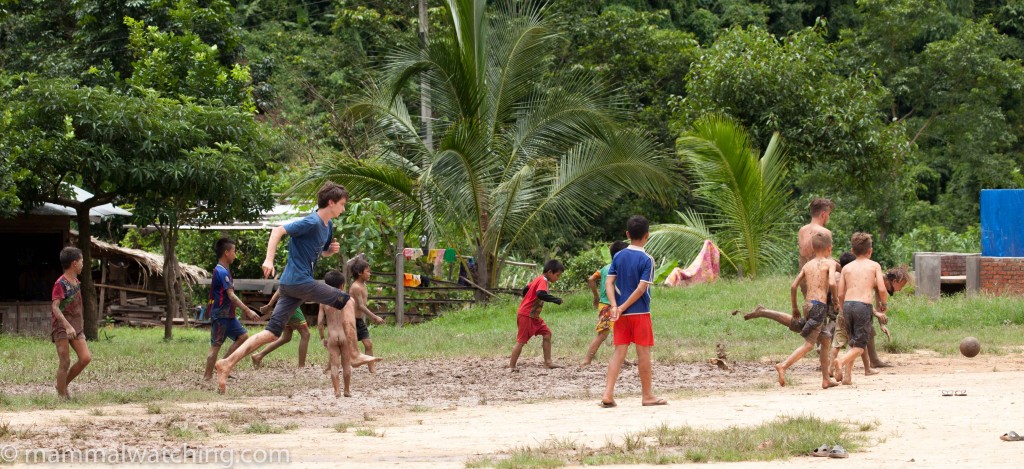
Patrick joins an impromptu soccer match in the village
5 Comments
-
-
Miles Foster
Thank you for a very interesting and informative post. Laos is on our ‘maybe list’ and some friends took the Gibbon Experience a few years ago. One of them got stuck on the zip wire as you did and I got the feeling that the mammal watching was not be all that great, though as usual you seem have done well under the circumstances. But it will not put the backpackers off I imagine, for them a little danger seems to be part of the attraction. I note that some have complained that the Camino del Rey in Spain is now too safe! So the Gibbon Experience and the forest it helps to protect seem likely to survive. I don’t think I’ll try it though.
-
Sara
I visited the Gibbon Experience in June and had a very similar experience on the zip line. It was terrifying, and certainly put a damper on the rest of my trip. To make matters worse, my guide said that I was the only person that he had ever known this to happen to. Lol. Guess that information was false! Like you, I did very much enjoy the forest, and was lucky enough to spot some gibbons. However, definitely would need a lot of persuasion to get me back on a zip line. Thanks for a well-written and interesting post!
Leave a Reply
You must be logged in to post a comment.


mattinidaho
Wow, that is quite a trip report, Jon, and one I wasn’t expecting. Unlike most of your trip reports, this one did not leave me clamoring to visit as soon as possible!